On this page
Books about ShrikesThe books are listed in order of publication date with the most recent at the top.
The Shrikes
Family: Laniidae
Shrikes on UK list:
Great Grey Shrike
Lanius excubitor
Southern Grey Shrike
Lanius meridionalis
Lesser Grey Shrike
Lanius minor
Steppe Grey Shrike
Lanius pallidirostris
Red-Backed Shrike
Lanius collurio
Isabelline Shrike
Lanius isabellinus
Woodchat Shrike
Lanius senator
Masked Shrike
Lanius nubicus
Long-tailed Shrike
Lanius schach
Brown Shrike
Lanius cristatus
Other true shrikes:
Tiger Shrike
Lanius tigrinus
Bull-headed Shrike
Lanius bucephalus
Burmese Shrike
Lanius collurioides
Emin's Shrike
Lanius gubernator
Souza's Shrike
Lanius souzae
Bay-backed Shrike
Lanius vittatus
Grey-backed Shrike
Lanius tephronotus
Mountain Shrike
Lanius validirostris
Loggerhead Shrike
Lanius ludovicianus
Chinese Grey Shrike
Lanius sphenocercus
Grey-backed Fiscal
Lanius excubitoroides
Taita Fiscal
Lanius dorsalis
Somali Fiscal
Lanius somalicus
Mackinnon's Shrike
Lanius mackinnoni
Common Fiscal
Lanius collaris
Newton's Fiscal
Lanius newtoni
Uhehe Shrike
Lanius marwitzi
Yellow-billed Shrike
Corvinella corvina
Magpie Shrike
Corvinella melanoleuca
White-rumped Shrike
Eurocephalus rueppelli
White-crowned Shrike
Eurocephalus anguitimens
|
|
|
|
Shrikes: A Guide to the Shrikes Of The WorldNorbert Lefranc and Tim Worfolk
Christopher Helm
2013
This is a reprint of the 2000 edition published by Pica
"Shrikes are a charismatic group of birds occurring throughout most of the Old World and North America. The family Laniidae consists of 31 species in three genera, if the Southern Grey Shrike and Great Grey Shrike are accepted as separate species which the author recommends. This book is the first to cover all the shrikes in one volume. .... Many species are of conservation concern including the Great Grey Shrike, The Lesser Grey Shrike, The Woodchat Shrike and the Red-backed Shrike in Europe and the Loggerhead Shrike in North America. The decline of these species has been largely caused by changing farming methods, but all are now legally protected. This brilliant book brings together the most recent information on the shrike family and the superb text and illustrations should lead to successful and safe identification of all species in the field."
|
Buy from amazon.co.uk 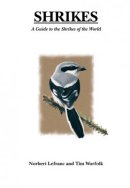
|
|
The True Shrikes (Laniidae) of the World: Ecology, Behavior and EvolutionE.N. Panov
Pensoft
2011
"This book is the first monograph in English on the 34 shrike species distributed across Africa, Eurasia and North America. These birds have attracted the attention of ornithologists for a long time, mainly because of their predatory nature and the methods which they use to dispatch their prey. In the book, the most important information on shrikes of the World is summarized, much of which has accumulated in the ornithological literature and obtained by the author himself. These voluminous empirical data are also used by the author in an attempt to reconstruct the evolutionary history of the group at different stages of its phylogenesis, from the early origins of the family Laniidae, presumably in Africa, through the secondary expansion of species across Eurasia and into the New World. Also examined here, all within the framework of an integral system of adaptation, are evolutionary trends affecting changes in bodysize and plumage coloration, foraging behavior, breeding dispersion, motor signal behavior and vocalizations. Special attention is paid to the devel opment of signal and communication behavior in groups of closely related species at different stages of their divergent evolution. The breakdown of iso lating mechanisms, leading to hybridization and a local fusion of closely related species in their sec ondary contact zones, its causes and dynamics, is another fascinating topic dealt with in the book. The results of recent molecular studies on shrikes are discussed as well."
|
Buy from amazon.co.uk 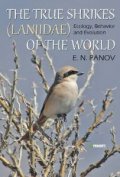
|
|
Shrikes and Bush-shrikes: Including Wood-shrikes, Helmet-shrikes, Shrike Flycatchers, Philentoemas, Batises and Wattle-eyesTony Harris
Illustrations: Kim Franklin
Christopher Helm
2000
"This book covers 114 species within the families Laniidae and Malaconotidae. 41 colour plates depict all species showing differences in sex, age, geographical variation, and flight pattern. The plates are accompanied by identification captions and colour distribution maps. The text includes individual species accounts with sections on field identification, plumage, geographical variation, distribution, movements. general and foraging behaviour, food, sounds and breeding behaviour."
|
Buy from amazon.co.uk 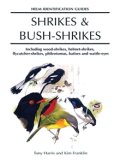
|
|
Shrikes and Bush-shrikes: Including Wood-shrikes, Helmet-shrikes, Shrike Flycatchers, Philentoemas, Batises and Wattle-eyesTony Harris
Illustrations: Kim Franklin
Princeton University Press
2000
"Shrikes are a group of spectacular predators, many with brilliant colors and striking displays and sounds. Located in North America, Eurasia, and Africa, they occupy a wide spectrum of terrestrial habitats, from sparsely vegetated deserts to tropical forests, and have diverse foraging and breeding strategies. Capturing this diversity is the primary goal of Shrikes and Bush-Shrikes, the first field guide to cover the identification, biology, and relationships of all 114 species of shrikes and their close relatives. All species are portrayed in 41 beautiful color plates, consisting of over 480 illustrations that depict differences in sex, age, geographical variation, and flight pattern. Facing the plates are identification captions and color distribution maps for at-a-glance reference. Detailed species accounts provide current knowledge on field identification, plumage descriptions, geographical variation, moult, distribution, movements, foraging behavior, food, sounds, and breeding behavior. The guide provides an explanation of the history of relationships within the group, highlighting issues of conservation and species identification. For each genus, acoustic and visual signals are summarized and used to map similarities in an effort to identify species from the perspective of behavioral communication. Shrikes and Bush-Shrikes responds to the great interest in shrikes that has developed over the last century, along with controversies surrounding their origins and classification. It offers new identification strategies as well as extensive information in a format designed to please everyone from birders to conservationists to ornithologists."
|
Buy from amazon.co.uk 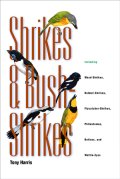
|
|
Shrikes of the World II: Conservation ImplementationEditor: Reuven Yosef and Fred E. Lohrer
International Birdwatching Center Technical Publication 7
1998
Proceedings of the Second International Shrike Symposium, 17-23 March 1996, International Birdwatching Center in Eilat, Israel.
|
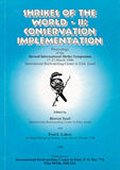 |
|
Shrikes: A Guide to the Shrikes of the WorldNorbert Lefranc and Tim Worfolk
Pica
1997
"A comprehensive guide to 31 species of "true" shrike from all over the world. Includes information on distribution, general behaviour, ecology and conservation, as well as identification features."
|
Buy from amazon.co.uk 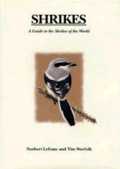
|
|
Shrikes (Laniidae) of the World: Biology and ConservationEditor: Reuven Yosef and Fred E. Lohrer
Proceedings of the Western Foundation of Vertebrate Zoology
Volume 6 Number 1
1995
|
Buy from amazon.co.uk 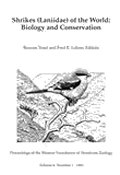
|
|
Shrikes Of Southern AfricaTony Harris
Colour plates: Graeme Arnott
Struik Winchester
1988
224 pages with 34 full page colour plates, 25 full page colour sketches and a number of line drawings. Covers true shrikes, helmet-shrikes and bush-shrikes. A limited collector's edition was published in addition to the standard edition.
|
Buy from amazon.co.uk 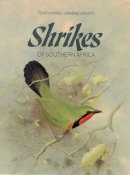
|
|
Cuckoos And Shrikes In Relation To Agriculture
The Food Of Cuckoos: F.E.L. Beal
The Food Of Shrikes: Sylvester D. Judd
Illustrations: J.L. Ridgway
Division Of Ornithology And Mammology Bulletin No. 9
US Department of Agriculture
Government Printing Office
1898
From the opening lines of the Shrikes section: Two species of shrikes inhabit North America. One, the loggerhead shrike (Lanius ludovicianus et subspec), is a permanent resident in the United States; the other, the butcherbird [Lanius borealis), visits us from the north in winter. Either might be mistaken for a mocking bird, but upon close inspection is seen to have the hooked beak of a hawk; instead of possessing talons, however, it has weak and slender feet, thus combining characters of a bird of prey with those of a song bird. During cold weather the shrike in wait for prey takes his stand on some high perch that commands a wide view. In this position he watches, ready to pounce on the first bird that twitters in the briers, or mouse that rustles in the grass. When the quarry has been secured, it is carried to a sharp twig or thorn and spitted, and then the hunter, ever eager to satisfy its desire for the chase, goes off to the hedgerows to search for more game.
|
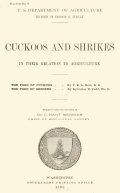
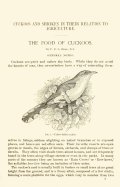 |
|
Catalogue Of The Passeriformes or Perching Birds In The Collection Of The British MuseumCichlomorphae: Part V, containing the families Paridae and Lanidae (Titmice and Shrikes) and Cerithiomorphae (Creepers and Nuthatches)
Catalogue Of The Birds In The British Museum, Volume VIII
Hans Gadow
9 colour plates: J. Smit
Printed By Order Of The Trustees
Printed by Taylor & Francis
1883
Preface: "The Eighth Volume of the 'Catalogue of Birds in the British Museum' contains an account of all the species of Titmice, Shrikes, Creepers, and Nuthatches known at present. It was prepared by Dr. H. Gadow, who has also completed the manuscript of the succeeding volume, which will contain the Cinnyrimorphae and is already in the press. The total number of species described amounts to 402, of which no less than 337 are in the British Museum; they are represented by 2944 examples. Of the principal donors I have to mention H. I. and R. Highness the Crown Prince Rudolph of Austria, B. H. Hodgson, Esq., F. D. Godman, Esq., 0. Salvin, Esq., Capt. Stackhouse Pinwill, W. E. and C. G. Gates, Esqrs., H. Seebohm, Esq., Lord Walsingham, Capt. Shelley, and Lieut.-Col. Irby. In consequence of the author's departure from London, it was found necessary to intrust the correction of the proof-sheets, and especially the revision of the lists of specimens, to the experience of Mr, Sharpe ; but all corrections were submitted to the author for his approval before the sheets were sent to press."
|
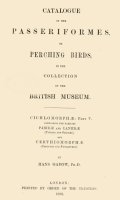
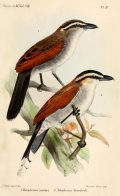
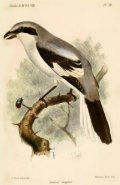 |
|